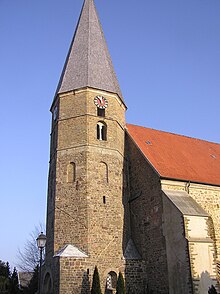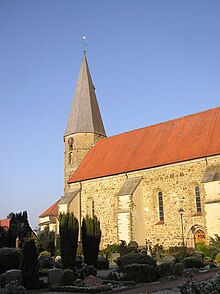St. George's Church (Badbergen)
The Evangelical Lutheran parish church of St. Georg in Badbergen was built in the Middle Ages on significantly older predecessor buildings. Its oldest part shows Romanesque forms. A special feature of this church, built from rubble stones, is the eight-sided substructure of the church tower. From 1651 to 1869 it was used as a simultaneous church.
Location and local conditions
The church is in the center of Badbergen, directly on the busy B 68 . It is surrounded by the cemetery to the south and east.
Foundation and foundation construction
The founding of the Badberg Church is in the dark, the written tradition goes back to 1221. In that year, Bishop Adolf (1216-1224) equipped the cathedral choir founded by him with an archdeaconate district, which received its center in Ankum and to which the parish ( parrochia ) Badbergen belonged. The Badberg Sendgericht has also been handed down from this time , so that the founding of the first church must be much further back.
Excavations carried out in 1985 in the tower, which is itself a remnant of an earlier church building, as well as traces of various predecessor buildings in the west yoke of the current building: A swelling-beam church with a semicircular choir is preceded by a wooden post building with a straight end. This wooden post church is the first documented evidence in the Diocese of Osnabrück .
Reformation and Counter Reformation
From 1571, evangelical preaching began in St. Georg. In the course of the following decades, the Badberg parish became almost entirely Lutheran. Due to the Treaty of Westphalia in Münster and Osnabrück in 1648 and the Badberg partition recession , the church became a simultaneous church from 1651 to 1869, i.e. it was used by both denominations. In 1866 the Catholic parish began building its own church ( St. Marien ).
Furnishing
The oldest piece of equipment is a Bentheim font from the 13th century. Four crouching lion figures carry the barrel-shaped basin, which is divided into three zones: In the lower area, arcades of a circumferential frieze enclose rosettes and mask-like human faces. In the middle, a vine with leaves and grapes surrounds the pool wall. The upper third is covered by a double rope. During the time when the church was shared by both denominations, the baptismal font was divided, as indicated by the flat, two-winged wooden lid that has been preserved.
The sacrament niche set into the east wall of the choir, described in 1710 as a “tabernacle with beautiful stone ornaments and portraits”, is an Osnabrück work from around 1500. The graceful figures on the right and left represent the apostles Peter (with the key) and John (with chalice and poisonous snake). They are probably neo-Gothic additions, as well as the base and crowning of the niche.
The baroque-style altar was created in 1960 using original elements from old altars by Karl Allöder .
organ
The large organ on the west gallery was built in 1988 by the organ building company Rudolf von Beckerath (Hamburg). The slider chests -instrument has 20 stops on two manuals and pedal. The playing and stop actions are mechanical.
|
|
|
|||||||||||||||||||||||||||||||||||||||||||||||||||||||||||||||||||||||||||||||||||||||||||||||||||||||||||
- Coupling : II / I, I / P, II / P
Web links
- Church district Bramsche: Ev. Lutheran St. George's Church in Badbergen ( Memento from July 18, 2012 in the Internet Archive )
- The Badberger division recession and the divided baptismal font
literature
- Herbert Schuckmann, Wolfgang Schlueter, Ulrike Heuer: Sankt Georg Badbergen. Contributions to the building history of a parish and collegiate church in the north of Osnabrück. Rasch 2001, ISBN 3-934005-93-4
- Heinrich Böning: Art Guide Bersenbrücker Land. Th. Thoben 1993, ISBN 3-921176-48-4
Individual evidence
- ^ Böning: Art Guide Bersenbrücker Land. P. 26
- ↑ Information on the organ of St. Georg
Coordinates: 52 ° 38 ′ 0.6 ″ N , 7 ° 58 ′ 54.5 ″ E


